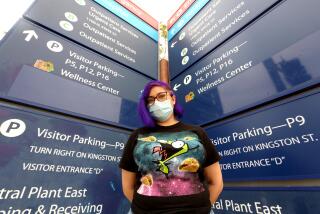Alternative Care for Mentally Ill : Health: Programs allow patients to forgo lengthy hospital stays for nights at home and a chance to practice what they’ve learned.
- Share via
Eleven days after a nervous breakdown, Anita, 62, thought she was ready to leave the psychiatric hospital.
She was beginning to come to grips with the intense family problems that had led to her severe anxiety. She was on medication that greatly helped. She missed having her own things and wanted to collect her mail and tend to her property.
But the staff at Pacific Shores Hospital in Oxnard hesitated to release her. They knew Anita would be returning to a much different place. Her husband of 42 years had left her on the day of her breakdown.
They compromised: Anita would go home for one day and night, pay her bills, water her lawn and straighten things up. Then she would return each day to the hospital, Monday through Friday, for therapy, going home each night.
“They were reluctant to let me go home to an empty house,” says Anita, who is doing well after five weeks of daily outpatient therapy. “But they let me go live at home and take part in the outpatient program. They didn’t just cut me off when I left the hospital. If they had, I couldn’t have recovered as easily.”
What is remarkable about Anita and thousands of people like her is that only a few years ago she probably would have been hospitalized for a month or longer for her condition.
But mental-health professionals, following the trend in outpatient medical care, are recognizing that they can successfully treat many of their patients without lengthy--and costly--hospitalizations.
A growing number of patients with serious depression, anxiety, and even schizophrenia, are being diverted into outpatient programs, also called day treatment or “partial hospitalization.”
Indeed, the trend is accelerating so fast that soon psychiatric hospitalization may be reserved for the very ill: those who are suicidal, homicidal or completely delusional or non-functioning.
“The overnight stay is disappearing,” says Mark Knight, executive director of the American Assn. for Partial Hospitalization, which represents 900 mental-health facilities nationwide. “Even very acute people can be successfully treated on an outpatient basis. We find there is high consumer satisfaction with these programs. It’s less disruptive. There is less stigma involved. And it’s much less formidable than dealing with a hospital stay.”
Partial hospitalization can take many forms: Some people spend their days at the hospital but go home at night. Others attend therapy sessions for three or four hours each evening after work. And some gradually decrease their hours in partial programs until they are completely discharged or shift to a one-hour weekly therapy session.
“We’re finding that 12% to 15% of the traditional inpatient market is now going to partial hospitalization,” says Knight. “Psychiatric hospitals are not completely abandoning their beds. But the beds are becoming more for crisis and stabilization, detoxification and those in need of a highly medical environment.”
Even if patients still require hospitalization, the stays are shorter, with more patients discharged to intensive day treatment programs. The average length of stay in a psychiatric hospital has been steadily shrinking, from an average of 25.6 days in 1990 to 19.8 days in 1992, says Carole Szpak, director of communications for the National Assn. of Psychiatric Health Systems.
The organization, which represents 300 private psychiatric hospitals, reports that nearly 90% of its members offer partial hospitalization, up from 75% in 1990. In fact, it recently changed its name from the National Assn. of Private Psychiatric Hospitals in order to reflect the shift from inpatient programs, Szpak says.
“Mental-health professionals now recognize that it makes sense to offer a whole range of services, from inpatient down,” she says.
While most patients and family endorse the trend, some mental-health professionals continue to oppose the shift to partial hospitalization. One fear is that shorter inpatient stays will result in more patients having relapses.
But, says Dr. Karen Fitzhugh, director of the Pacific Shores Hospital: “I’ve never talked to anyone who disagreed with it on the grounds that we are not providing patients with the treatment they need. I think it’s a problem of just wanting to do business as usual.”
Until recently, no alternative mental-health program existed between long hospitalization and a one-hour weekly therapy session, experts point out.
“In the past, if you had a crisis you had to go into the hospital because there wasn’t another option for you,” Fitzhugh says. “Someone with a major depression might have had a two- to three-week inpatient stay. Now, someone with a crisis might be stabilized in the hospital for three days. Then they are ‘stepped down’ into a partial-hospitalization program.”
The trend in partial hospitalization also is being fueled by insurers seeking less expensive modes of treatment. According to Knight, partial hospitalization costs about 30% to 60% as much as comparable inpatient treatment.
“This program allows consumers to get treatment at a reasonable cost,” says Fitzhugh.
Partial hospitalization also represents mental-health professionals’ new confidence that they can effectively treat difficult conditions without the tight security, control and monitoring provided in a psychiatric hospital.
“We know more now about the biology of mental illness,” Szpak says. “And we have better medications--another reason the length of a hospital stay can go down.”
The biggest therapeutic benefit, proponents say, is that patients can go home at night and practice what they learn during the day.
Beth, 29, entered the Pacific Shores partial-hospitalization program for chronic depression. She attends the program every day for six hours before returning to her parents’ home.
“There is enough time each day to really get in touch with your feelings,” she says. “If you were going to a therapist once a week, you couldn’t deal with some of these issues in depth. For example, I have learned to be a lot more assertive and speak up for myself at home.”
Says Fitzhugh: “Patients can go home and try out what they are learning. And we (the professionals) can watch what is happening in their real lives.”
Partial programs have been successful with patients who relapse easily, says Stephanie Fudurich, who oversees the partial program at Capistrano By The Sea hospital in Dana Point.
In one case, a patient with severe depression and anxiety was hospitalized repeatedly but would relapse after being discharged, Fudurich says. After her last hospitalization, the woman entered a partial program.
“She is doing wonderfully,” Fudurich says. “She found she was able to make the changes at home that she needed to make. She could utilize the skills she was learning and talk about what she was doing at home.”
The programs operate much like inpatient hospital programs, says Knight, in that they are highly structured. However, more emphasis is on group therapy.
“These patients can benefit from a community environment,” he says. “They discuss ways to cope and recover because they are in a community of other people like them.”
The patient’s family often becomes more involved in the treatment than they would have with hospitalization, Knight says. Particularly when the patient is a child or adolescent, this is helpful.
“The programs offer a lot of help to the family, getting them through something very confusing to them,” he says.
More to Read
Sign up for Essential California
The most important California stories and recommendations in your inbox every morning.
You may occasionally receive promotional content from the Los Angeles Times.










